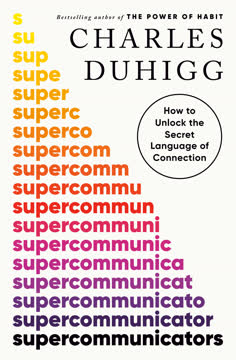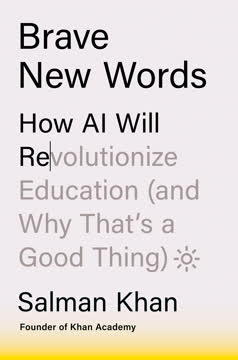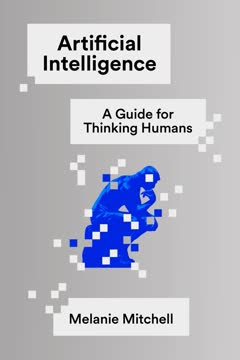Key Takeaways
1. AI is transforming work, learning, and human thinking
If the internet changed our relationship with knowledge, AI is going to change our relationship with thinking.
AI revolution underway. Artificial Intelligence is rapidly transforming every aspect of work, education, and human cognition. Unlike previous technological revolutions that primarily impacted manual labor, AI is poised to disrupt knowledge-based professions like law, medicine, and education. This shift is not just about automation, but about fundamentally altering how we process information, solve problems, and create.
Widespread impact. AI's influence extends beyond specific job functions:
- It's changing how we research, write, and communicate
- Altering decision-making processes in various fields
- Raising questions about creativity, originality, and human expertise
- Forcing a reevaluation of educational practices and learning outcomes
2. AI produces average work, raising the bar for human excellence
AI is the new C work. Unique but mostly average.
Redefining standards. AI's ability to produce consistently average-quality work is forcing a recalibration of performance standards across industries and education. This shift has significant implications:
- What was once considered acceptable human performance may now be subpar
- Employers and educators must raise expectations for human contributions
- The value of uniquely human skills like critical thinking, creativity, and emotional intelligence is increasing
Implications for education and work:
- Students need to aim higher than AI-level performance to remain competitive
- Assignments and assessments must be redesigned to evaluate higher-order thinking skills
- Workplaces will expect employees to add value beyond what AI can produce
3. AI literacy is essential for future success in all fields
AI literacy is an important new skill.
Universal need for AI competency. As AI becomes ubiquitous, the ability to effectively use and understand AI tools is becoming a core competency across all disciplines. This literacy encompasses:
- Understanding AI's capabilities and limitations
- Knowing how to craft effective prompts and interpret AI outputs
- Recognizing potential biases and ethical considerations in AI use
- Ability to critically evaluate AI-generated content
Integration into education. To prepare students for this AI-driven future:
- AI literacy should be integrated across the curriculum, not just in computer science courses
- Students need hands-on experience with AI tools in various contexts
- Ethical considerations and responsible AI use must be part of the discussion
4. New strategies needed to maintain academic integrity in the AI era
Detection will continue to have its uses, but it can't be our primary response.
Beyond detection. Traditional approaches to academic integrity, focused on detecting cheating, are becoming less effective in the age of AI. New strategies are needed:
- Emphasize the value of original thinking and human creativity
- Design assignments that leverage AI while still requiring unique human input
- Focus on process and thinking skills rather than just final products
- Develop clear policies on appropriate AI use in academic work
Rethinking assessment. Educators must adapt their evaluation methods:
- Move away from easily AI-replicable tasks
- Incorporate more real-time, in-person assessments
- Use portfolio-based evaluations that showcase student growth and process
- Implement peer review and collaborative projects that highlight human interaction
5. AI can enhance creativity and problem-solving abilities
AI is going to make us all more creative.
AI as a creative partner. Rather than stifling human creativity, AI has the potential to enhance it:
- AI can generate a vast quantity of ideas, overcoming human mental blocks
- It can make unexpected connections, sparking new insights
- AI's lack of social inhibitions can lead to more unconventional ideas
Leveraging AI for innovation:
- Use AI to brainstorm and explore a wide range of possibilities
- Combine AI-generated ideas with human judgment and refinement
- Employ AI to visualize concepts or prototype designs quickly
- Utilize AI to overcome creative blocks or explore new directions
6. Effective AI use requires clear prompts and iterative refinement
Good enough is constantly changing.
The art of prompting. Maximizing AI's potential requires skill in formulating effective prompts:
- Be specific about the desired output, format, and context
- Provide relevant background information and constraints
- Use clear, unambiguous language
Iterative process. Getting the best results from AI often involves:
- Starting with a broad prompt and refining based on initial outputs
- Asking follow-up questions to clarify or expand on AI responses
- Combining multiple AI outputs to create a more comprehensive result
- Human curation and editing of AI-generated content
7. AI-assisted education demands reimagined assignments and assessments
All assignments are now AI assignments.
Rethinking educational tasks. Traditional assignments and assessments need to be redesigned to:
- Incorporate AI as a tool rather than trying to prevent its use
- Focus on higher-order thinking skills that AI can't easily replicate
- Emphasize application, analysis, and synthesis of information
- Encourage students to critically evaluate and improve upon AI-generated content
New assignment types:
- Collaborative projects combining AI and human inputs
- Real-time, in-class activities that showcase individual thinking
- Assignments that require students to explain their AI use and decision-making process
- Projects that apply course concepts to novel, real-world situations
8. Motivation and process-focused learning are crucial in the AI age
I care, I can, I matter.
Intrinsic motivation. With AI able to complete many basic tasks, fostering student engagement becomes even more critical:
- Emphasize the relevance and personal value of learning
- Provide opportunities for autonomy and choice in assignments
- Create a sense of belonging and community in the learning environment
Focus on process. Shifting attention from outcomes to the learning process:
- Make thinking visible by requiring students to document their problem-solving steps
- Use reflective practices to encourage metacognition
- Implement formative assessments that provide feedback on learning strategies
- Design assignments that value iteration and improvement over perfection
9. AI feedback and role-playing offer new educational opportunities
AI can also be a debate partner.
AI as a learning assistant. Leveraging AI for personalized learning experiences:
- Use AI to provide immediate, customized feedback on student work
- Create AI-powered tutoring systems that adapt to individual learning needs
- Employ AI for language practice or simulated conversations
Role-playing and simulation. AI enables new forms of experiential learning:
- Historical figure interviews or debates
- Simulated professional scenarios (e.g., client interactions, ethical dilemmas)
- Practice in different communication styles or cultural contexts
- Exploration of complex systems through AI-powered simulations
10. Writing instruction must adapt to incorporate AI tools responsibly
Writing is what AI does best, and you can't out-prompt AI.
Redefining writing pedagogy. As AI becomes proficient at generating text, writing instruction needs to evolve:
- Focus on higher-level skills like critical analysis, argumentation, and synthesis
- Teach students to effectively use AI as a writing aid (e.g., for brainstorming, editing)
- Emphasize the importance of voice, style, and originality in writing
- Incorporate more collaborative and multimodal writing projects
Ethical considerations. Addressing the ethical implications of AI in writing:
- Develop clear guidelines for appropriate AI use in academic writing
- Teach students to critically evaluate and fact-check AI-generated content
- Emphasize the importance of proper attribution and transparency in AI use
- Discuss the broader societal implications of AI-generated text (e.g., misinformation, authenticity)
Last updated:
FAQ
What's "Teaching with AI: A Practical Guide to a New Era of Human Learning" about?
- Overview: The book, authored by José Antonio Bowen and C. Edward Watson, explores the transformative impact of artificial intelligence (AI) on education, focusing on how AI is changing the way we think, teach, and learn.
- Structure: It is divided into three parts: Thinking with AI, Teaching with AI, and Learning with AI, each addressing different aspects of AI's integration into education.
- Purpose: The book aims to provide educators with practical guidance on leveraging AI to enhance teaching and learning while addressing ethical and equity concerns.
- Association: Published in association with the American Association of Colleges and Universities, it emphasizes the importance of AI literacy for both faculty and students.
Why should I read "Teaching with AI: A Practical Guide to a New Era of Human Learning"?
- Relevance: As AI becomes increasingly integrated into various aspects of life, understanding its impact on education is crucial for educators, students, and policymakers.
- Practical Guidance: The book offers actionable strategies and examples for incorporating AI into teaching practices, making it a valuable resource for educators looking to adapt to technological changes.
- Ethical Considerations: It addresses the ethical implications of AI in education, providing insights into how to use AI responsibly and equitably.
- Future Preparedness: Reading this book can help educators prepare students for a future where AI literacy is essential for success in the workforce.
What are the key takeaways of "Teaching with AI: A Practical Guide to a New Era of Human Learning"?
- AI Literacy: The book emphasizes the importance of AI literacy as a core skill for both educators and students, necessary for navigating the future job market.
- AI as a Partner: It highlights the potential of AI to enhance creativity, productivity, and learning when used as a collaborative tool rather than a replacement for human effort.
- Ethical Use: The authors stress the need for ethical considerations in AI use, advocating for policies that ensure equitable access and prevent misuse.
- Redefining Education: The book suggests that AI will fundamentally change educational practices, requiring a reevaluation of teaching methods, assessment strategies, and learning outcomes.
How does "Teaching with AI" suggest educators integrate AI into their teaching practices?
- AI-Assisted Tools: The book recommends using AI tools to automate routine tasks, such as grading and feedback, allowing educators to focus on more complex teaching activities.
- Customized Learning: It suggests leveraging AI to provide personalized learning experiences, adapting content and assessments to meet individual student needs.
- Creative Collaboration: Educators are encouraged to use AI as a partner in creative processes, helping students generate ideas and explore new perspectives.
- Ethical Discussions: The book advises incorporating discussions about AI ethics and implications into the curriculum to prepare students for responsible AI use.
What are the ethical considerations discussed in "Teaching with AI"?
- Bias and Equity: The book addresses concerns about AI perpetuating biases present in training data and emphasizes the need for equitable access to AI tools.
- Privacy Concerns: It highlights the importance of protecting student data and ensuring that AI systems are transparent about how data is used.
- Accountability: The authors discuss the need for clear policies on AI use in education, ensuring that students and educators understand their responsibilities.
- Misinformation Risks: The book warns about the potential for AI to generate misinformation and stresses the importance of teaching students to critically evaluate AI-generated content.
How does "Teaching with AI" address the issue of AI and cheating?
- Detection Challenges: The book acknowledges the limitations of AI detection tools and the potential for false positives, urging caution in their use.
- Redefining Cheating: It suggests that what is considered cheating may need to be reevaluated in the context of AI, focusing on the value of human effort and creativity.
- Preventive Strategies: The authors propose designing assignments that emphasize process and critical thinking, making it harder for students to rely solely on AI.
- Educational Integrity: The book emphasizes the importance of fostering a culture of integrity and transparency in AI use, encouraging students to disclose their use of AI tools.
What are some practical examples of AI tools mentioned in "Teaching with AI"?
- Research Tools: The book mentions tools like Consensus and Elicit, which connect to databases to provide accurate citations and synthesize research findings.
- Feedback Systems: AI can be used to provide immediate, personalized feedback to students, helping them improve their work in real-time.
- Creative Applications: Tools like Midjourney and Stable Diffusion are highlighted for their ability to generate creative content, such as images and designs.
- Administrative Support: AI can assist with administrative tasks, such as scheduling and organizing student interactions, freeing up educators' time for teaching.
How does "Teaching with AI" propose to redefine quality in education?
- AI as Baseline: The book suggests that AI-generated work should be considered the new baseline for average work, pushing students to exceed this standard.
- Higher Standards: It advocates for raising the bar on what is considered quality work, emphasizing critical thinking, creativity, and originality.
- Rubric Adjustments: Educators are encouraged to adjust grading rubrics to reflect the capabilities of AI, ensuring that human contributions are valued.
- Focus on Process: The book emphasizes the importance of assessing the process and effort behind student work, rather than just the final product.
What are the best quotes from "Teaching with AI" and what do they mean?
- "AI is going to change our relationship with thinking." This quote highlights the transformative impact of AI on cognitive processes, suggesting that AI will alter how we approach problem-solving and creativity.
- "What faculty call cheating, business calls progress." This statement reflects the differing perspectives on AI use, emphasizing the need to align educational practices with real-world applications.
- "AI literacy will need to include how to find the right AI for the job." This quote underscores the importance of teaching students to critically evaluate and select appropriate AI tools for specific tasks.
- "AI is a tool that can elevate the creativity and productivity of everyone." This highlights the potential of AI to enhance human capabilities, encouraging its use as a collaborative partner.
How does "Teaching with AI" suggest educators handle AI-generated content in student work?
- Transparency: The book advises requiring students to disclose their use of AI tools and to provide transcripts of AI interactions when submitting assignments.
- Process Documentation: It suggests asking students to document their writing process, including
Review Summary
Teaching with AI receives mostly positive reviews, with readers praising its practical advice and ideas for incorporating AI in education. Many find it informative and accessible, offering valuable insights for educators. The book is commended for its numerous prompts and examples. Some criticisms include a lack of focus on ethics and privacy concerns, and a few readers express reservations about rapidly adopting AI in teaching. Overall, reviewers appreciate the book's guidance on adapting to AI's growing presence in education.
Similar Books









Download PDF
Download EPUB
.epub digital book format is ideal for reading ebooks on phones, tablets, and e-readers.




